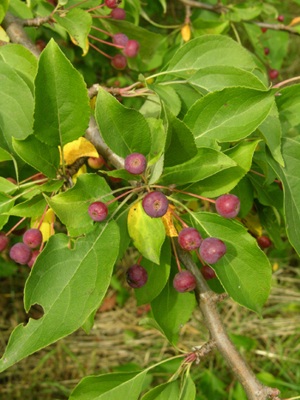Relatives
Malus baccata (L.) Borkh. - Siberian crabapple.
Taxonomic position.
Family Rosaceae Juss., genus Malus Mill.Synonyms.
Pyrus baccata L., P. microcarpa Wendl. ex C. Koch, Malus pallasiana Juz., M. Chamardabanica V. Vartapetjan et L. SolovjevaMorphology and biology.
Tree 5(10) m tall or large shrub with gray stems and branches. Young offshoots are yellowish or grayish brown, fulvous, bare. Leaves are (2)3-7(10) cm long and 1-4(6) cm wide, ranging from elliptical to ovate and oblong-ovate, sharp with a rounded base, crenate-serrate or sharply serrated along the entire edge, bare (young ones have light pubescence on the underside) or pubescent only along the mid-vein. Petioles vary from bare to pubescent, 2-4(8) cm long. Flowers are grouped 4-8(10) in umbels, set on thin, bare pedicels 2-6 cm long. Sepals are lanceolate, approximately twice as long as the hypanthium, bare and ciliate from the outside, tomentose from the inside, caducous under fruit. Hypanthia are cyathiform-ascidiform, bare. Corollas are white or pale pink, 2-4 cm in diameter, glandular. Fruits are 5-10 mm in diameter, spherical, sometimes slightly elongated and yellow with a red tint, orange or red. Entomophilous. Ornito- and zoochore. Plant is propagated by seed, root and softwood cuttings. Seeds need to be stored for 2-3 months at 3-5╓C. Blossoms in May; bears fruit in September and retains fruit for the entire winter. 2n = 34.Distribution.
Occurs in Eastern Siberia (the basin of the upper Angara, valley of the Irkut River, Tunkinskaya Hollow, Trans-Baikal, isolated occurrence in Kartuzsky District of Krasnoyarsk Region), the Far East (Amur River basin and littoral territories), Mongolia and China.Ecology.
Mesophyte. Photophilous. It is drought-resistant. It grows as isolated plants in river flood lands, on forest edges, in glades, and, less frequently, under the canopy of thin, light-coniferous forests.Utilization and economic value.
Used as a food (fruit), ornamental and melliferous. The most valuable qualities of this crabapple include high winter-tolerance (survives temperatures as low as -50╓C) and early appearance of fruit, which is crucial for apple breeding in northern horticultural areas. Has long been widely utilized in park landscaping.Reference citations:
Brezhnev D.D., Korovina O.N. 1981. Wild relatives of cultivated plants in the flora of the USSR. Leningrad: Kolos. 237-238 p. (In Russian)Kharkevich S.S., ed. 1996. Vascular plants of the Soviet Far East. Vol. 8. Leningrad: Nauka. 153 p. (In Russian)
Koropachinskiy I.Yu., Vstovskaya T.N. 2002. Woody plants of the Asian part of Russia. Novosibirsk: Publishing House of SB RAS, Branch Geo. 330-331 pp. (In Russian)
Malyshev, L.I. & G.A. Peshkova, eds. 1988. Flora of Siberia. Vol. 8. Rosaceae. Novosibirsk: Nauka. 25 p. (In Russian)


